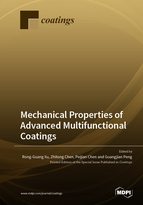Mechanical Properties of Advanced Multifunctional Coatings
A special issue of Coatings (ISSN 2079-6412).
Deadline for manuscript submissions: closed (28 February 2022) | Viewed by 34416
Special Issue Editors
Interests: multifunctional coatings; coatings synthesis; coating characterization; multiscale modeling; mechanical behaviors
2. Institute of Biomedical and Health Engineering, Shenzhen Institute of Advanced Technology, Chinese Academy of Sciences, Shenzhen 518055, China
Interests: plasma physics; plasma medicine; medical devices
Special Issues, Collections and Topics in MDPI journals
Special Issue Information
Dear Colleagues,
Advanced multifunctional coatings have always attracted a lot of attention due to the great and unpredicted progress in their synthesis, characterization, and properties. They have also been widely used in different fields, such as aeronautics, transportation, biomedicine, electrical and electronic equipment, etc. Mechanical properties are key to how advanced multifunctional coatings interact with external forces and environmental factors. An in-depth understanding of mechanical properties of these coatings, however, still requires complex material modeling and characterization tools. This Special Issue aims to present the latest findings and to promote further research in the areas of mechanical behaviors of advanced multifunctional coatings, including experimental characterization and theoretical calculations. Full papers, review articles, and communications are all welcome.
Potential topics include but are not limited to the following topics:
- Advanced multifunctional coatings in mechatronics;
- Advanced characterization methods and tools;
- Advanced coatings for preparation and applications;
- Numerical simulations and computational modeling, including FEM/XFEM, MD, MC, DFT, etc.;
- Theoretical studies;
- Design and synthesis strategies affecting mechanical behaviors;
- Industrial case studies.
Dr. Rong-Guang Xu
Dr. Zhitong Chen
Prof. Dr. Peijian Chen
Prof. Dr. Guangjian Peng
Guest Editors
Manuscript Submission Information
Manuscripts should be submitted online at www.mdpi.com by registering and logging in to this website. Once you are registered, click here to go to the submission form. Manuscripts can be submitted until the deadline. All submissions that pass pre-check are peer-reviewed. Accepted papers will be published continuously in the journal (as soon as accepted) and will be listed together on the special issue website. Research articles, review articles as well as short communications are invited. For planned papers, a title and short abstract (about 100 words) can be sent to the Editorial Office for announcement on this website.
Submitted manuscripts should not have been published previously, nor be under consideration for publication elsewhere (except conference proceedings papers). All manuscripts are thoroughly refereed through a single-blind peer-review process. A guide for authors and other relevant information for submission of manuscripts is available on the Instructions for Authors page. Coatings is an international peer-reviewed open access monthly journal published by MDPI.
Please visit the Instructions for Authors page before submitting a manuscript. The Article Processing Charge (APC) for publication in this open access journal is 2600 CHF (Swiss Francs). Submitted papers should be well formatted and use good English. Authors may use MDPI's English editing service prior to publication or during author revisions.







